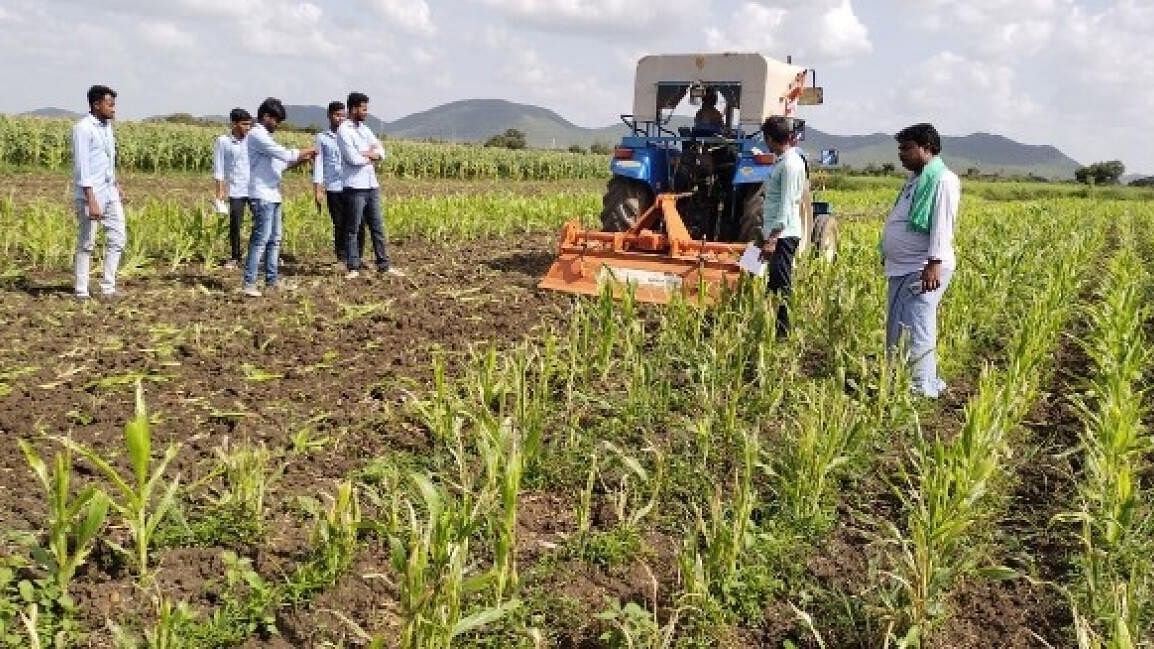
Maize plants being cleared in the fields at a village in Rattihalli taluk of Haveri district.
Credit: DH Photo
After scanty rainfall caused extensive damage to kharif crops, farmers now fear the drought situation will affect rabi cultivation more severely in Dharwad, Gadag and Haveri districts, where most farmlands are rain-fed areas.
A large number of farmers are anxious about the rabi season which has already started, as rains required for maintaining moisture in the soil for the second crop seem unlikely.
Green gram and maize form the major chunk of kharif crops in the undivided Dharwad district, along with cotton and soybean. Drought has forced several farmers to clear withered green gram plants and maize plants with green leaves but no yield. Though farmers are hoping for some rain to help the sowing of Bengal gram, wheat, jowar, safflower and other rabi crops in a few weeks, the situation seems to be worsening, casting a shadow on the rabi season too.
“I planted green gram on 10 acres of land in the first half of June. I had to destroy the plants now, as they are totally dried up. I had spent over Rs 15,000 per acre. Rains came in July, but a dry August spoiled everything,” says Gangadhar Badnikai, a farmer at Kusugal village in Dharwad district. He now intends to borrow money to sow crops for the rabi season.
Farmers are destroying their green gram plants in Gajendragad taluk of Gadag district, maize plants in Laxmeshwar taluk of Gadag district, as well as Shiggaon and Rattihalli taluks of Haveri district. “We were in tears while destroying the maize plants we had grown,” says Gadigeppa Harijan of Suranagi village in Laxmeshwar taluk.
Crops like onion and chilli were also damaged. Only a small percentage of farmers who could get water from nearby rivers or sources like borewells were able to save their crops.
According to Dharwad-based University of Agricultural Sciences (UAS) Agromet Department Head R H Patil, the scattered rains being seen this month are not helpful for rabi sowing, as the soil’s moisture level is still not up to par. “As the situation is uncertain, rabi sowing now is risky. There will be some respite in rabi season only if very good rains come in before October end,” he adds.
Drought-hit tags
Among the 23 taluks of Dharwad, Gadag and Haveri districts, 16 taluks were declared by the state government as severely drought-hit last month. Inter-ministerial central team also visited some places to study the drought situation.
In the second round, the government has now declared the remaining seven taluks in these districts as severely drought-hit. With this, all taluks in these districts now officially have the tag of severely drought-hit.
The overall deficit of rainfall this monsoon has been not much in these three districts mainly due to heavy rains in the month of July. However, the deficit in rainfall was more than 60 per cent in both June and August, causing crop damage.
Sowing of different agricultural crops during this kharif season was targeted on 2.56 lakh hectares of land in Dharwad district, 3.09 lakh hectares in Gadag district and 3.30 lakh hectares in Haveri district. But actual sowing was much lower due to the delayed monsoon. For instance, Gadag saw only 64 per cent sowing against the target.
Agriculture Department Joint Director for Gadag district Taramani G H says that sowing of Bengal gram and other rabi crops would definitely be affected if the rain falls short. She said crop loss during kharif was also severe.